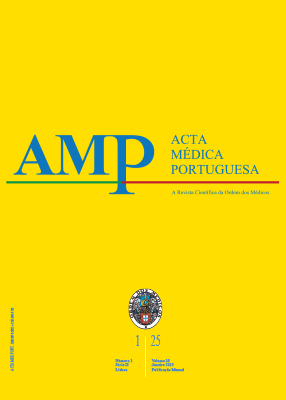Meningitis Due to Haemophilus influenzae Serotype A and Adenovirus: A Rare Case of Co-Infection in a Six-Month-Old Infant
DOI:
https://doi.org/10.20344/amp.21725Keywords:
Adenoviridae Infections, Haemophilus Infections, Haemophilus influenzae, Infant, Meningitis, BacterialAbstract
Haemophilus influenzae serotype A is a rare cause of meningitis and invasive disease in pediatric patients. A six-month-old infant presented to the emergency room with fever, cough and nasal drip. On admission, the infant was alert and hemodynamically stable but progressively became more lethargic with bulging of the fontanelle. The blood tests revealed a normal leukocyte count and elevated C-reactive protein. Cytology and biochemistry of the cerebrospinal fluid were consistent with bacterial meningitis and treatment with ceftriaxone was initiated. Both blood and cerebrospinal fluid cultures were positive for Haemophilus influenzae. Serotyping of the strain identified Haemophilus influenzae serotype A. Viral detection in cerebrospinal fluid and nasopharyngeal aspirate tested positive for adenovirus. The infant completed 10 days of antibiotic therapy and was fully recovered upon discharge. Although cases of Haemophilus influenzae serotype a meningitis are rare, invasive disease caused by non-B serotypes as well as non-encapsulated isolates have been increasing, emphasizing the need for monitoring and continuous epidemiological surveillance.
Downloads
References
Bajanca-Lavado MP, Cavaco L, Fernandes M, Touret T, Candeias C, Simões AS, et al. Haemophilus influenzae carriage among healthy children in Portugal, 2015-2019. Microorganisms. 2022;10:1964.
Watt JP, Wolfson LJ, O’Brien KL, Henkle E, Deloria-Knoll M, McCall N, et al. Burden of disease caused by haemophilus influenzae type b in children younger than 5 years: global estimates. Lancet. 2009;374:903- 11.
Ulanova M, Tsang RS. Invasive haemophilus influenzae disease: changing epidemiology and host-parasite interactions in the 21st century. Infect Genet Evol. 2009;9:594-605.
Pittman M. Variation and type specificity in the bacterial species haemophilus influenzae. J Exp Med. 1931;53:471-92.
Butler DF, Myers AL. Changing epidemiology of haemophilus influenzae in children. Infect Dis Clin North Am. 2018;32:119-28.
Heliodoro CI, Bettencourt CR, Bajanca-Lavado MP, Portuguese Group for the Study of Haemophilus Influenzae Invasive Infection. Molecular epidemiology of invasive haemophilus influenzae disease in Portugal: an update of the post-vaccine period, 2011–2018. Eur J Clin Microbiol Infect Dis. 2020;39:1471-80.
Campos J, Hernando M, Roman F, Perez-Vazquez M, Aracil B, Oteo J, et al. Analysis of invasive haemophilus influenzae infections after extensive vaccination against h. influenzae type b. J Clin Microbiol. 2004;42:524-9.
Ulanova M, Tsang SW. Haemophilus influenzae serotype a as a cause of serious invasive infections. Lancet Infect Dis. 2014;14:70-82.
Tsang RS, Shuel M, Wylie J, Lefebvre B, Hoang L, Desai S, et al. The epidemiology of invasive haemophilus influenzae non-serotype b disease in Ontario, Canada from 2004 to 2013. PLoS One. 2016;11:805- 13.
Ulanova M, Tsang RS. Invasive non-type b haemophilus influenzae disease: report of eight cases. J Med Microbiol. 2014;63:805-8.
Ribeiro GS, Reis JN, Cordeiro SM, Lima JB, Gouveia EL, Petersen M, et al. Prevention of haemophilus influenzae type b (hib) meningitis and emergence of serotype replacement with type a strains after introduction of hib immunization in Brazil. J Infect Dis. 2003;187:109-16.
Angulo López I, González Escartín E, Aguirre Quiñonero A, Ots Ruiz E. Meningitis simultánea por neumococo y enterovirus en lactante. Enferm Infecc Microbiol Clin. 2017;35:128-30.
Jung J, Seo E, Yoo RN, Sung H, Lee J. Clinical significance of viralbacterial codetection among young children with respiratory tract infections: findings of RSV, influenza, adenoviral infections. Medicine. 2020;99:e18504.
Korppi M, Leinonen M, Mäkelä PH, Launiala K. Mixed infection is common in children with respiratory adenovirus infection. Acta Paediatr Scand. 1991;80:413-7.
Pick AM, Sweet DC, Begley KJ. A review of pediatric bacterial meningitis. US Pharm. 2016;41:41-5.
Downloads
Published
How to Cite
Issue
Section
License
Copyright (c) 2024 Acta Médica Portuguesa

This work is licensed under a Creative Commons Attribution-NonCommercial 4.0 International License.
All the articles published in the AMP are open access and comply with the requirements of funding agencies or academic institutions. The AMP is governed by the terms of the Creative Commons ‘Attribution – Non-Commercial Use - (CC-BY-NC)’ license, regarding the use by third parties.
It is the author’s responsibility to obtain approval for the reproduction of figures, tables, etc. from other publications.
Upon acceptance of an article for publication, the authors will be asked to complete the ICMJE “Copyright Liability and Copyright Sharing Statement “(http://www.actamedicaportuguesa.com/info/AMP-NormasPublicacao.pdf) and the “Declaration of Potential Conflicts of Interest” (http:// www.icmje.org/conflicts-of-interest). An e-mail will be sent to the corresponding author to acknowledge receipt of the manuscript.
After publication, the authors are authorised to make their articles available in repositories of their institutions of origin, as long as they always mention where they were published and according to the Creative Commons license.









